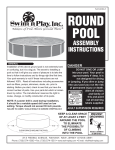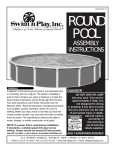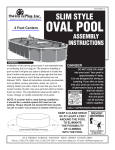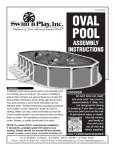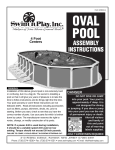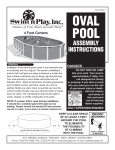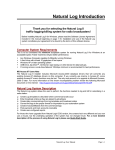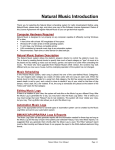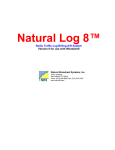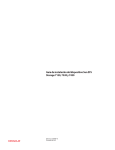Download ROUND Pools CENTURY Specifications
Transcript
Part# 420363-16 CENTURY ROUND POOLS POOL ASSEMBLY INSTRUCTIONS GENERAL Installation of this above ground pool is not extremely hard or confusing, but it is a big job. The secret to installing a pool so that it will give you years of pleasure is to take the time to follow instructions and do things right the first time. Your pool warranty is void if these instructions are not followed 100%. Read all instructions including accessories such as filters, pumps, skimmers, decks, etc. prior to starting. Before you start, check to see that you have the correct number of parts. Use your parts list which is broken down by carton. The manufacturer reserves the right to revise, change, or modify construction of its pools. NOTE: If a power drill is used during installation, it should be a variable speed drill used on low setting. Torque should not exceed 39 inch pounds. FAILURE TO COMPLY COULD RESULT IN SCREWS STRIPPING OUT. DANGER DO NOT DIVE OR JUMP into your pool. Your pool is approximately 4' deep. It is not designed for diving or jumping. If you dive or jump into your pool you run the risk of permanent injury or death. Alert all visitors and family of this and point out all warning labels supplied. ADULT SUPERVISION REQUIRED www.century-pools.com • E-mail: [email protected] CONTRACT INSTALLATIONS The manufacturer is in no way affiliated with any professional pool installer. Therefore the manufacturer can assume no responsibility for errors in installation by the home owner or said professional installer. If you have your POOL installed by others, please supervise them to be sure they comply with the proper installation techniques shown. Their past experience or short cuts may not cover the latest improvements in our POOLS. Do not allow any short cuts of any nature. LOCAL CODES • Local building code may require obtaining a building permit and or an electrical permit. The installer shall follow the regulations on set backs, barriers, devices and other conditions. • Any after market or home built deck should be built to the local building code requirements, including load capacity and fencing requirements. • All electrical outlet connections should be a minimum of 5 feet from the outside perimeter of the wall of the pool. From 5-10 feet there should be either a fixed connection (outlet box) or twist lock connection with a GFCI. Connect power cords to a 3-wire grounding-type outlet only. • Severe electrical shock could result if you install your pump or filter on a deck. They could fall into the water, causing severe shock or electrocution. Do not install on a deck or other surface at, above or slightly below the top ledge of the pool. BARRIER REQUIREMENTS • If the distance from the top of the assembled pool is less than 48" vertically from the surrounding grade, a fence or barrier is needed to surround the pool with a minimum height of 48". • A barrier is necessary to provide protection against potential drowning and near drowning and is not a substitute for constant supervision of children. A barrier is a fence, wall, or a combination thereof which completely surrounds the swimming pool and obstructs access to the swimming pool. Barriers must comply with local and national building codes and the US Consumer Product Safety Commission. • These are minimum fencing and barrier requirements. Check your local building codes for other requirements they may request. Optional fencing kits are available, Please contact your local dealer. • If pool covers are used for safety barriers they should comply with ASTM F 1346 "Standard Performance Specification for Safety Covers and Labeling Requirements for All Covers for Swimming Pools, Spas and Hot Tubs." SPECIAL CARE Even though this manufacturer's pools are designed to meet or exceed industry recommended safety factors, special attention must be paid to some installation procedures that the installer performs and controls. • Levelness Spend the time to assure that the entire pool framework is level within 1". Unlevel pools place extreme pressures on the pool walls. • Wall seam This area is where the wall joins together. Damage to any part of this area reduces the safety factors and can result in a weak pool. Use extreme care following instructions. • Earth mound This keeps the liner from creeping out from under the pool wall. Follow instructions to the letter – don't short-cut or substitute materials. Improperly installed pools can rupture, allowing thousands of gallons of water to rush out causing extensive property damage and injury to anyone in its path. • This manufacturers pools are not designed to be buried. Outside ground forces can collapse pool wall. Certain conditions may exist, like the levelness of the pool area that require the pool to be recessed. You must maintain a finished pool height of 36” above ground level. If your pool is 48” deep, you may recess the pool by 12” (48”-36”=12”). Consult your local pool professional and building codes as to the use of earth retaining walls to recess your pool deeper than this recommended amount. Make sure that the pool remains full of water for at least 7 days before backfilling the pool recess. Place a layer of plastic film against the pool before backfilling to protect the pool from corrosion agents that may be found in the backfill materials. • The pool owner has the sole responsibility for providing adequate lighting for the pool area. • All users must be able to see the shallow depth of the pool, and safety signs at all times. • You must install a pool ladder(s) and/or steps for entry and exit from the pool. • The use of artificial pool lighting is at the discretion of the pool owner. • All electrical components shall be installed in accordance with Article 680 of the National Electrical code 1999 (NEC®) “Swimming Pools, Fountains and Similar Installations” or its latest approved edition. 2 • During night time pool use, artificial lighting shall be used to illuminate all safety signs, ladders, steps, deck surfaces and walks. • The installer shall follow written instructions provided for operation of the circulation system. • Decks shell meet local codes and comply with ANSI/NSPI-8 1996 “Model Barrier Code for Residential Swimming Pools, Spas and Hot Tubs” or the latest approved edition. Screwdriver Hammer • Underwater lights having front access shall be installed and removed only with use of tools. • The installer of the vinyl liner shall affix on the original or replacement liner, or on the pool structure, all safety signs in accordance with the manufacturer’s instructions. The safety signs shall be placed above the water line. Tape All components such as the filtration system, pumps and heater shall be positioned so as to prevent their being used as a means of access to the pool by young children. Hoe Knife INTRODUCTION The installation of an average size pool (12' - 30' diameter) will usually require three people to help set it up. Listed is an assortment of tools and materials which you will need for preparing the ground, checking the levelness, and setting up the pool. SELECTING POOL LOCATION Rake Shovel 4” Nail The selection and preparation of the pool site is your responsibility. The manufacturer can only suggest the proper techniques, indicate the important considerations and emphasize the precautions, and cannot be held responsible for damages to your pool that may result from failure to carefully follow all pool site specifications. 1. The surface on which your pool will stand must be ABSOLUTELY LEVEL AND SOLID. This condition should extend one (1) foot beyond the actual pool area all around. The best surface is bare solid earth free from stones, roots, and other sharp objects. Broom Pliers Patio Blocks 2. Allow plenty of play area around the pool. Fit the location into your landscaping plans. 3. The pool site must be accessible to electrical and water supply and should allow for disposal of great quantities of water when pool is drained. 4. When installing your pool on a SOLID LEVEL SURFACE, it is imperative that you protect your pool and liner from chemicals and other foreign matter contained in the surface. Protect your pool and liner by inserting between them and the surface any material that is not made from a tar derivative or contains sharp twigs, etc. We suggest the use of a plastic ground shield to be used between the surface and the pool liner (See step 2). Do not install your pool on peat moss, tar paper, gravel or chemically treated soil not approved for pool use. Any or all of these surfaces can ruin your pool and liner and will void your warranty. 5. Do not set up your pool under trees or under overhead wires. 6. DO NOT set up your pool near any existing structure such as your house garage, etc., as this condition will induce diving or jumping into your pool which could result in permanent injury or death. 7. Do not set up your pool on or near any septic system or underground utilities. 8. Choose your pool location convenient for: a. Connecting electrical wires of your accessories (filter, heater, lights) to your electrical outlets conforming to electrical codes. b. Draining large amounts of water. Carpenters Level Cloth Tape 2x4 Center Stake Sifted Earth or Pre Washed Sand SOME FRIENDS TO HELP OUT 3 INSTALLATION • ASSEMBLY STEPS READ CAREFULLY BEFORE STARTING POOL ASSEMBLY CONSTRUCTION CLOSE-UPS Use the illustrations below as a guide for the assembly of your pool 6” 6” DELUXE POOLS DELMAR ELAN • OMNI LEXINGTON POOLS PRINCETON QUANTUM ZENITH • ST. CROIX POOLS with Box Vertical OPTIONAL Fig. A 4 Fig. B Fig. C INSTALLATION • ASSEMBLY STEPS READ CAREFULLY BEFORE STARTING POOL ASSEMBLY CONSTRUCTION CLOSE-UPS Use the illustrations below as a guide for the assembly of your pool 6” EXTRUDED ALUMINUM POOLS with Box Vertical Fig. D 7” XL POOLS with Column Vertical Fig. E 9” POOLS Fig. F 5 INSTALLATION • ASSEMBLY STEPS READ CAREFULLY BEFORE STARTING POOL ASSEMBLY CONSTRUCTION CLOSE-UPS Use the illustrations below as a guide for the assembly of your pool 7” XL POOLS DELUXE POOLS SUPREME POOLS 6 with Column Vertical & Wrap Around Covers with Column Vertical & Wrap Around Covers with Wrap Around Covers Fig. G Fig. H Fig. I PREPARING THE GROUND 1 Your pool must be installed on a solid level surface. Drive a stake into the ground at the center of your pool location. Use a length of string tied to the center stake, see clearance chart for your size pool, and mark the area using a can of spray paint or flour. With the use of the leveling device shown and a shovel, start leveling the ground, removing all grass and sharp objects such as sticks and stones. Level area to the lowest spot within the clearance radius. DO NOT FILL IN LOW SPOTS. Give special attention to the outer part of the circle as this is where the bottom track and pool wall will rest and must be absolutely level. 2”x 4” DO NOT FILL IN NAIL DIG AWAY HERE CLEARANCE RADIUS CENTER STAKE CARPENTER’S LEVEL CLEARANCE RADIUS=1/2 POOL DIAMETER + 6" LEVEL AREA CLEARANCE RADIUS The assembled pool must have a vertical distance of 3' from the top of the pool to the adjoining grade and the adjoining grade must remain level for a distance of 4' away from the pool. Refer to the drawing at right. 12' Pool 15' Pool 18' Pool 21' Pool 24' Pool 27' Pool 30’ Pool = = = = = = = 6' 6" 8' 9' 6" 11' 12' 6" 14' 15’ 6” 3 FT. 4 FT. PREVIOUS GRADE WARNING - LEVELING THE GROUND THIS IS THE MOST IMPORTANT PART OF YOUR PREPARATION OF POOL SITE. YOU MUST GIVE CAREFUL ATTENTION TO THIS PHASE. REMEMBER — YOUR POOL MUST BE INSTALLED ON SOLID LEVEL SURFACE. 7 BOTTOM RAILS 2 CENTER STAKE BOTTOM RAIL BOTTOM RAIL VERTICAL BOTTOM PLATE PRE WASHED SAND OR SIFTED EARTH RECOMMENDED REQUIREMENT CHART 12 ft. 1.4 Tons 1.1 Yards 15 ft. 1.9 Tons 1.5 Yards 18 ft. 2.6 Tons 2.1 Yards 21 ft. 3.4 Tons 2.7 Yards 24 ft. 4.4 Tons 3.5 Yards 27 ft. 5.4 Tons 4.3 Yards 30 ft. 6.5 Tons 5.2 Yards OPTIONAL GROUND SHIELD BOTTOM PLATE PATIO BLOCK 1/16” Ground Shield and Wall Guard are optional. Spread a ground shield or plastic sheeting over prepared ground (not included). Ground Shield and Wall Guard are available from your local pool supply dealer or polyethylene sheeting can be purchased from a local hardware supply. This will protect your pool liner and metal parts against chemical reactions from the ground soil. Mark out pool radius (1/2 pool diameter) using the center stake as reference. Form a circle by sliding bottom rail groove up, into the bottom plates 1/16" from the stop. To prevent stones or other foreign material from damaging the liner it is recomended to build a 2” to 3” base of sand inside the entire pool. Bring the required amount of clean and washed masonry sand into the pool area at this time. Refer to chart above for the required amount. Place the patio blocks under each bottom plate at ground level. Check the levelness from the center stake to each bottom plate. INSERT WALL INTO BOTTOM RAILS SKIMMER INLET SKIMMER OUTLET 8 3 Remove wall from carton. NOTE: the UP arrow on wall. Determine starting point as the filter inlet and outlet holes are at the beginning of the wall. Starting at the center of a bottom plate insert the bottom edge of the wall into the groove on the bottom rail. Ensure that the center line of the closure holes in the the wall align with the center of the plate. Make sure that the cutouts 4’ x 4’ Plywood for filter inlet and outlet are on the top portion of the wall and will not be hidden behind a vertical. If the wall ends do not meet, adjust the bottom rail in or out of the bottom plates. The spacing in all bottom plates should be equal. CLOSING THE WALL A 4 3/8" TRUSS HEAD SCREW 1/4" x 20 x 3/4" TRUSS HEAD 4 CLOSURE SCREW INSIDE OF POOL 1/4" x 20 SERRATED FLANGE NUT Wall Pool B WASHER BARS View from the top Wall Pool Wall Pool WASHER 3/8 FLANGE NUT DANGER DANGER YOU MUST ASSEMBLE THE POOL WALL AS PER INSTRUCTIONS USE ALL THE 1/4"-20x3/4" TRUSS HEAD SCREWS AND 1/4"-20 SERRATED FLANGE NUTS TO CLOSE POOL WALL. DO NOT LEAVE ANY OPEN HOLES TIGHTEN EACH SCREW TO 85 INCH POUNDS. Insert the 1/4" - 20x3/4" truss head screws from inside the pool through the preattached inside closure bar, through inside and outside wall ends, and through outside closure bar. The 1/4" serrated flange nuts are secured to the screws on the outside of the wall. All the holes must match and be secured together with the screws and nuts provided. Tighten each screw and nut to 85 inch pounds of torque. If no torque wrench is available, tighten each nut until snug. Then tighten each nut one (1/2) half additional turn. If nut appears to be lose after tightening, please check if the screw is stripped or broken. It must be replaced. Recessed Posi-Lock System During this assembly procedure, make sure that one washer is on the inside of the pool, and one washer in on the outside of the pool sandwiching the two wall ends between them. Also ensure that the recesses of the walls and washers all face the same direction. YOU MUST ASSEMBLE THE POOL WALL AS PER INSTRUCTIONS USE ALL THE 3/8-16x3/4" TRUSS HEAD SCREWS, WASHERS AND 3/8-16 SERRATED FLANGE NUTS TO CLOSE POOL WALL. DO NOT LEAVE ANY OPEN HOLES TIGHTEN EACH SCREW TO 85 INCH POUNDS. Align the holes in the wall ends. From the inside of the pool, insert a 3/8 Truss Head screw through the washer, through the holes on the inside and outside wall ends, and through the second washer. Fasten with 3/8 serrated flange nut on the outside of the pool having the flange of the nut face the washer. Only hand tighten the nuts at this point. Continue for each hole in the wall ends. DO NOT LEAVE ANY OPEN HOLES. Tighten all screws and nuts to 85 inch pounds. If no torque wrench is available, tighten each nut until snug. Then tighten each nut one half (1/2) additional turn. If nut appears to be lose after tightening, please check if the screw is stripped or broken. If it is, it must be replaced. Overtightening the nuts could cause the screws to fracture which could result in pool failure. Failure to tighten the nuts sufficiently could also result in pool failure. This is one of the most important structural assembly aspects you will perform. Be absolutely sure you have assembled the wall as shown above for your pool. Manufacturer can not assume the responsibility of the performance of this product if the instructions of closing the wall are not followed exactly. 9 PROTECT YOUR LINER WALL SEAM INSIDE OF POOL VIEW 5 SKIMMER RETURN FITTING VIEW FROM INSIDE OF POOL SKIMMER INLET FITTING 3 LAYERS OF TAPE way from top to bottom of wall. If the filter inlet and outlet are not used, cover over the pre-scored areas on the inside of the pool wall with 1 layer of tape. If your Pool Wall has the Recessed Posi-Lock System an additional layer of tape should be added to the inside part of the extended end of the wall. WALL SEAM CLOTH TAPE OR DUCT TAPE 3 LAYERS OF TAPE INSIDE OF POOL VIEW Once the wall is closed and screws and nuts are tightened securely, cover the screw heads on the inside of the pool with 3 layers of cloth tape all the EXTENDED END OF WALL Cloth tape or duct tape is available through your local pool dealer or hardware store. RECHECKING YOUR WORK POOL WALL Using the center stake make sure your pool is completely in true round by measuring from the center of the stake to inside of pool wall in all directions, making sure these measurements are equal. IUS RAD CENTER STAKE 6 VIEWED FROM ABOVE Remove center stake from pool area after measurements and adjustments, if necessary, are made. EARTH MOUND 7 OPTIONAL WALL GUARD Wall guard is optional. Tape wall guard (plastic sheeting) to pool wall 12" up from ground and smooth out on ground 12" from wall. This will protect your pools metal parts from chemical reactions with the soil used in the earth mound. Several commercial products can also be used in place of earth mound. Consult your professional pool dealer. 8” Build earth mound on top of wall guard using screened damp earth or pre-washed sand. Shape and compact earth mound to run 8" up from ground and 8" away from the wall. Do not use any material that will compress under pressure for the earth mound is an important part of the pool installation. It prevents the wall from lifting up and the liner from sneaking underneath the pool wall. Spread the remaining sand equally across the bottom of the pool. This will give you a 2“ to 3” sand base. Manufacturer cannot assume responsibility of the performance of this product if the earth mound is omitted or not properly installed. 10 EARTH MOUND 12” DANGER DO NOT USE ANY MATERIAL THAT WILL COMPRESS UNDER PRESSURE FOR THE EARTH MOUND. SEE INSTRUCTIONS TO LEFT. 12” 8” THRU-THE-WALL SKIMMER 8 IMPORTANT!! BEFORE CONTINUING WITH THIS STEP YOU MUST KNOW WHICH TYPE OF THROUGH THE WALL SKIMMER YOU WILL BE USING WITH YOUR POOL Your pool wall has cutouts to accomodate both standard size skimmers and deluxe wide mouth skimmers. If you have a wide mouth skimmer, you will be required to remove the entire cutout as shown in figure 1. To remove the section, you can use either tin snips or a hammer and knife as shown in figure 3. If you have a standard size skimmer, only remove the inside section of the cutout, and place duct tape around the remaining scored sections as shown in figure 2. 1 LARGE SKIMMER CUT OUT ENTIRE AREA 2 SMALL SKIMMER CUT INSIDE AREA ONLY On inside of wall, tape over holes and slots that will not be used with duct tape or any other cloth tape. 3 If the through wall filter inlet and outlet holes are to be used, remove metal cutouts by breaking perforations using a knife and hammer as shown. Refer to skimmer manufacturer's instructions for remainder of skimmer assembly. Make sure skimmer does not leak as this will corrode the pool wall and cause a split in the wall that is not covered under the pool warranty. It is recommended to coat the exposed metal on both sides with a clear lacquer or nail polish to help resist rust and corrosion. 11 LINER INSTALLATION 9 CAUTION LINER YOUR POOL IS DESIGNED TO PROVIDE AN AMPLE SAFETY MARGIN WHEN IT STANDS ON LEVEL GROUND. FOR THIS PURPOSE A SLOPE IN EXCESS OF 2 INCHES IN ANY DIRECTION WALL TO WALL IS CONSIDERED OFF LEVEL YOUR POOL WARRANTY ONLY APPLIES TO POOLS INSTALLED ON LEVEL GROUND AS DEFINED ABOVE. ONCE YOU HAVE STARTED TO FILL THE POOL, DO NOT TRY TO PULL THE LINER FORCEFULLY. THE WEIGHT OF EVEN ONE INCH OF WATER WILL MAKE IT IMPOSSIBLE TO MOVE THE LINER WITHOUT DAMAGING IT. POOL LINER TOP RAIL INCORRECT CORRECT POOL WALL AIR SPACE POOL LINER PLASTIC EDGING EARTH MOUND STANDARD OVERHANG LINER VINYL LINER 1. Clear all sticks and sharp objects from an area near the pool, that is as large as the pool itself. Remove the liner from its carton and unfold and open the liner. Refold the liner so that it can easily be carried to the pool and unfold from the outside of the pool. Check the levelness of the sand in the pool and make sure that no sharp objects are still in the pool. 2. Place the liner into the pool while holding onto the top of the wall section of the liner. Overhang the top wall of the liner over the pool wall approximately 4” and hold it by temporarily placing the plastic edging over the liner and the wall. Continue in this manner around the entire pool. OUTSIDE VIEW OF POOL WALL 3. Gently pull on the liner and use a soft bristle broom to remove as many wrinkles as possible on the bottom of the pool. Adjust the overhang of the liner as needed as you go trying to keep it as equal as possible around the pool. 4. Be sure that the seam of the liner where the wall meets the floor of the liner is evenly centered in the pool. Start filling the pool slowly with water. Continue pulling gently and working the liner with a broom, and readjusting the overhang as necessary. 5. Some wrinkling of the liner may be evident and in no way affects the structural strength of your pool. Once the water is filled to a point that the liner is pressed firmly against the wall install the thru-the-wall skimmer following its instructions. Then you can fill the entire pool as quickly as desired. The excess liner material overhanging the wall can either be trimmed later when the pool is filled, or double folded now to the inside of the pool between the liner and the wall. Permanently install the plastic edging around the entire pool, not leaving any gaps. 12 EZ HOOK LINER INSTALLATION ATTENTION: An 8 inch cove must be placed all around the inside of the pool 1. Clear all sticks and sharp objects from an area near the pool, that is as large as the pool itself. Remove the liner from its carton and unfold and open the liner. Refold the liner so that it can easily be carried to the pool and unfold from the outside of the pool. Check the levelness of the sand in the pool and make sure that no sharp objects are still in the pool. OPTIONAL WALL GUARD 8” COVE 2. Place the liner into the pool while holding onto the top of the wall section of the liner. 12” 8” 12” 3. Place the EZ Hook of the liner onto the top of the wall around the entire pool. Temporarily place a few of the top rails over the liner edging to support and sturdy the wall. Continue in this manner around the entire pool. TOP RAIL 4. Gently pull on the liner and use a soft bristle broom to remove as many wrinkles as possible on the bottom of the pool. EZ HOOK VINYL LINER 5. Start filling the pool slowly with water. Continue pulling gently and working the liner with a broom as needed. 6. Some wrinkling of the liner may be evident and in no way affects the structural strength of your pool. Once the water is filled to a point that the liner is pressed firmly against the wall install the thru-the-wall skimmer following its instructions. Then you can fill the entire pool as quickly as desired. POOL WALL OUTSIDE VIEW OF POOL WALL BEADED LINER INSTALLATION 1. Clear all sticks and sharp objects from an area near the pool, that is as large as the pool itself. Remove the liner from its carton and unfold and open the liner. Refold the liner so that it can easily be carried to the pool and unfold from the outside of the pool. Check the levelness of the sand in the pool and make sure that no sharp objects are still in the pool. 2. Install the bead receiver onto the top of the pool wall. Temporarily place a few of the top rails over the bead receiver to support and sturdy the wall. 3. Place the liner into the pool while holding onto the top of the wall section of the liner. 4. Snap the bead of the liner into the bead receiver around the entire pool. 5. Gently pull on the liner and use a soft bristle broom to remove as many wrinkles as possible on the bottom of the pool. 6. Start filling the pool slowly with water. Continue pulling gently and working the liner with a broom as needed. 7. Some wrinkling of the liner may be evident and in no way affects the structural strength of your pool. Once the water is filled to a point that the liner is pressed firmly against the wall install the thru-the-wall skimmer following its instructions. Them you can fill the entire pool as quickly as desired. 13 PRE-ASSEMBLY OF TOP PLATES* 10 * NOTE: CAGE NUTS NOT NEEDED ON ALL POOLS - CHECK YOUR PACKING LIST Before the top plates are installed it is necessary to attach the cage nuts* in their appropriate locations as shown in the figures at right. Using a pliers, squeeze together the spring sides of the cage nuts and insert them TOP PLATE WITH CAGE NUT CAGE NUT into the top plate from underneath. PLIERS TOP PLATE 1/4” CAGE NUT TOP PLATE CAGE NUT PLIERS VERTICALS, TOP PLATES AND RAILS 11 No. 12 x 1/2” Sheet Metal Screw VERTICAL If fencing or decking is to be installed, refer to the deck and fence instructions before installing verticals. The holes indented in the face of the verticals must be on top. If your pool is equipped with feature tape, it is best to apply it to the verticals at this time. Attention: If your pool has the 2 piece resin vertical, insert the flat piece into the vertical before installation, as shown. 14 Insert two rails into a plate, in No. 12 x 1/2” Sheet Metal the same manner and using the Screw same spacing as you have done on the bottom rail and plate assembly. Push the rails and plate assembly onto the plastic edging leaving the far end in the air. RAIL PLASTIC EDGING TOP PLATE MAKE SURE THAT THE TOP PLATE IS CENTERED DIRECTLY ON TOP OF THE BOTTOM PLATE. Attach the vertical to the top and bottom plate using the No.12x1/2" Sheet Metal Screws. Insert the exposed end of a top rail into another top plate with a top rail inserted into the opposite side. Push the top plate with rails onto the edging again leaving the far end of the rail in the air. Continue in this manner all the way around the pool. 15 INSTALLING LEDGES AND PLACEMENT OF WARNING LABELS 12 SCREW HOLE LOCATION GUIDE Refer to the "Construction Close-ups" at the beginning of these Instructions as indicated below: (4" Ledge/ 4" Vertical) (6" Ext. Ledge/ 6" Old Extruded Vertical) FIG. A (6" Ledge/ 6" Vertical) FIG. B (6" Ledge/ 6" Vertical) FIG. C, D, E, G, H & I (6” Ext. & 7" Ledge/ 6" Box Vertical) FIG. F (9" Ledge/ 8" Box Vertical) A A 12 ft. 15 ft. 18 ft. 21 ft. 24 ft. ROUND ROUND ROUND ROUND ROUND 27 ft. 1 1 B&D B&E B&E C&E C&E A&D A&D A&D A&D A&E A&E A&D A&D A&E A&E 1 3 2 2 E&C E&C E&C E&B E&B E&B E&B E&C E&C E&C E&B E&B E&B E&B A&D A&D A&D A&E A&E A&E A&E A&C A&C A&C A&D A&D A&D A&D A A B B C C B B C 1 D E E D 2 30 ft. ROUND ROUND C B B C DE E DC 3 D E E D No. 12 x 1/2” Sheet Metal Screw INSTALLING LEDGES ON BAR HARBOR & RIO VISTA MODEL POOLS ONLY Place ledges over the wall with each end resting on a top plate. Using the above chart Attention: You must use the 5/16” x 3/4” OD Stainless Steel Washers with each Sheet Metal Screw to secure the as a guide align the set of holes in the top plate as shown in the above drawing for your top ledges to the top plates. Failure to use the washers may result in damaged ledges. size pool with the holes in the ledge and Place ledges over the wall with each insert the No.12x1/2" Sheet Metal Screw end resting on a top plate. Align the through the ledge and into the top plate. set of holes in the top plate as The actual screw holes that are used does shown in the instructions for your not affect the integrity of the pool. You may size pool with the holes in the ledge use the set of holes that line up best! and insert the No.12x1/2" Sheet The ledge screws should not be tightened Metal Screw through the washer until all the ledges are in place and the and the ledge and into the top plate. pool has been filled with water. Your pool is equipped with (3) three special warning ledges. The (1) one ledge with a large warning on top is to be installed by the entry point into the pool and is not to be obstructed by any object such as your ladder. The (2) two ledges with the warning on the inside are to be placed opposite the entry point into the pool with the warning facing the entry point. THESE WARNINGS ARE NOT TO BE REMOVED UNDER ANY CIRCUMSTANCES NOTE: Your pools top ledge was not designed to be a walk around. Caution everyone who uses your pool NOT TO WALK OR SIT ON THE LEDGE! If your pool is equipped with feature tape it is best to apply it to the ledges at this time. 16 INSTALLING TOP COVERS 13 FOLLOW THE INSTRUCTIONS BELOW FOR THE COVERS FOR YOUR PARTICULAR POOL 4", 6" & 7" DELUXE TOP COVERS These covers don’t require cage nuts or top cover screws. For pools with the new 1-piece deluxe top covers, simply snap the cover into place, aligning the tab on the bottom of the cover with the slot in the top plate of pool (fig.A only.) A For 2-piece covers, insert bottom section into top (fig. 1) so that it becomes one unit (fig. 2). Then snap cover into place aligning tab on bottom of cover with slot in the top plate of pool (fig. 3) and secure with a #10 x 1" screw (fig. 4). 1 2 3 4 #10X1” SELF TAPPING SCREW IMPORTANT: Make sure that the inside edge of the top cover is securely positioned over the edge of the ledges 17 6" & 7" TWO-PIECE FULL CONTOURED COVER Slide inside cover (the cover which will be closest to the inside of the pool) into position and place outside cover onto top of inside cover aligning the holes together with cage nut attached to the top plate and secure using the 1/4”-20 x 3/4” screw provided. The two (2) edges of the covers should be parallel. Before tightening the screws, press the two covers firmly together. Line up the hole in bottom of cover with the hole in the vertical and fasten securely using the No. 10 x 1” self tapping sheet metal screw provided. 1/4”-20 X 3/4” OUTSIDE FULL STAINLESS STEEL SCREW CONTOURED COVER INSIDE COVER OUTSIDE FULL CONTOURED COVER #10X1” SELF TAPPING SCREW If your pool vertical does not have a hole, simply use the cover as a template and drill through the vertical using a 9/64" diameter drill bit, being careful not to damage the pool wall. NOTE: CAGE NUTS AND TOP COVER SCREWS NOT NEEDED FOR THIS STYLE. COVERS FOR 9" LEDGE POOLS Using a #10 x 1" sheet metal screw, attach the bottom cover to the vertical using the hole shown at right. CORRECT LEDGE COVER BOTTOM It is very important that the ledge be fitted inside the tab in the bottom cover as shown below. Make sure that the ledge remains in this position. INCORRECT LEDGE COVER BOTTOM TOP COVER Hook the underside inside part of the top cover under the ledge as shown. Then lower the top cover until it rests evenly on the ledge. Place a ¼"-14 x 1" self-tapping screw through the slot in the bottom cover and screw into the hole in the top cover. Be careful not to overtighten! 18 LEDGE COVER BOTTOM 1/4”-14x1” SELF TAPPING SCREW 7" AND 9” TWO-PIECE WRAP AROUND COVER AND PEDESTAL Slide the inside cover (the cover which will be closest to the inside of the pool) into position and align the hole in the cover with the cage nut attached to the top plate. Secure using the 1/4”-20 x 3/4” screw provided. Slide the outside cover onto the inside cover. Make sure the inside cover is in the slot of the outside cover. Align the holes on the side of the bottom wrap with the holes on the top of the vertical. Secure the cover using the #12 x 1/2” screws provided. The two (2) edges of the covers should be parallel. Before tightening the screws, press the two covers firmly together. 1/4”-20 X 3/4” STAINLESS STEEL SCREW INSIDE COVER 9” WRAP AROUND COVER 7” WRAP AROUND COVER #12X1/2” SCREW 1 ON EACH SIDE If your pool vertical does not have holes, simply use the cover or the pedestal as a template and drill through the vertical using a 9/64" diameter drill bit, being careful not to damage the pool wall. WRAP AROUND PEDESTAL Place the pedestal onto the bottom of the vertical and align the holes on the side of the wrap with the holes on the bottom of the vertical. Secure the pedestal using the #12 x 1/2” screws provided. #12X1/2” SCREW 1 ON EACH SIDE 19 7" XL TWO-PIECE WRAP AROUND COVER AND PEDESTAL 1 - Insert the logo into the cover. 2 - Slide the outside cover into position and align the hole in the cover with the cage nut attached to the top plate. Secure using the 1/4”-20 x 3/4” screw provided. 3 - Insert the back of the top cover onto the back of ledges. and securely snap the top cover into the hole in the front of the out side cover. 4 - Align the holes on the side of the bottom wrap with the holes on the top of the vertical. Secure the cover using the #12 x 1/2” screws provided. 7” XL WRAP AROUND COVER 2 1/4”-20 X 3/4” STAINLESS STEEL SCREW 1 LOGO OUTSIDE COVER TOP COVER 3 4 #12X1/2” SCREW 1 ON EACH SIDE WRAP AROUND PEDESTAL If your pool vertical does not have holes, simply use the cover or the pedestal as a template and drill through the vertical using a 9/64" diameter drill bit, being careful not to damage the pool wall. 1 - Insert the logo into the pedestal. 2 - Place the pedestal onto the bottom of the vertical and align the holes on the side of the wrap with the holes on the bottom of the vertical. 3 - Secure the pedestal using the #12 x 1/2” screws provided. 1 2 3 #12X1/2” SCREW 1 ON EACH SIDE 20 WARNING WARNING LABELS 14 Four (4) danger labels have been provided for your safety. Apply these labels to the pool where they are easily visible to all persons using the pool. To do this, simply peel the backing off the label to expose the self stick back and firmly press to a conspicuous and plainly visible surface on the pool. DO NOT REMOVE THE DANGER OR WARNING LABELS UNDER ANY CIRCUMSTANCES POOL USER WARNING LABELS 15 The manufacturer has provided warning signs to prevent diving and/or jumping into your pool. Alert all pool users to these signs. Should you need additional labels for any reason, the manufacturer will supply these labels to you at your request. Simply order the desired label by part number either from your local dealer or direct from the manufacturer. #490090 #490021 #490091 SAFETY BROCHURES AND EDUCATION PROGRAMS 16 Educational programs and materials, (i.e. seminars, workshops, brochures, videos, instructional guides, etc.) are available from NSPI, NSPF, other aquatic safety groups, and by private firms. As a means of communicating useful safety information to pool owners and users industry members are permitted to provide such information to owners and to request or require owners to sign a statement that they have received, read and will follow the guidelines. The following books are available through the National Pool & Spa Institute: "The Sensible Way To Enjoy Your Aboveground/Onground Swimming Pool" ...published by the NSPI "Children Aren't Waterproof" ...published by the NSPI "Layers of Protection" ...published by the NSPI "Pool and Spa Emergency Procedures For Infant And Children" ...published by the NSPI Contact: APSP 2111 Eisenhower Avenue Alexandria, VA 22314 (703) 838-0083 www.NSPI.org Contact: NSPF 10803 Gulfdale Suite 300 San Antonio, TX 78216 (210) 525-1227 www.NSPF.org 21 SAFETY TIPS - RULES AND REGULATIONS This section is designed to acquaint you with some guidelines as to the safe operation and use of your pool. • • Do not dive or jump into your pool. Your pool is approximately 48" or 52” deep. It is not designed for diving or jumping. If you dive or jump into the pool, you run the high risk of permanent injury or death. Alert all family members and guests of this fact. Point out the DO NOT DIVE labels supplied with the pool. • Do not install a slide or a diving board as your pool is approximately 48" or 52” deep and not designed to be used with them. A list of emergency phone numbers of the following should be conspicuously posted and should be kept at hand at the phone nearest to the pool: A. B. C. D. Nearest available police, fire and or rescue unit. Nearest available physician. Nearest ambulance service. Nearest available hospital. • Never permit the pool to be used unless at least one person other than the bather is present. Children must always be under careful adult supervision. • Never leave the pool open and unattended. Remove the ladders or other means of entry when it is unattended. As a further precaution, the pool should be covered when it will not be used for any extended period of time. • Do not walk on, climb on, sit on, stand on, or dive from the top seat of the pool. It is not designed for this. If you do, you run a risk of permanent injury or death from a serious fall. • Never run the filter while there are swimmers in or around the pool. Be sure electrical hook-ups comply with national and Local electrical codes. • Do not dispense chemicals into the pool while the pool is being used. Poisoning or painful skin irritations can occur. • Do not permit horseplay or dangerous water games in and around your pool. Remember that the pool area may be wet and slippery, and accidents resulting in serious injuries can be prevented if rules of behavior are strictly enforced. • Keep the water sanitary and healthful at all times, maintain pool sanitation with the use of a good filter system and the regular application of water purifying chemicals. Unsanitary water is a potential health and safety hazard. • Lighting should be provided to illuminate safety signs, deck surfaces, and walks during nighttime pool use. • Do not allow toys, chairs, tables, filtration system's pumps, heaters or other objects that a young child could climb, to be within four feet (4') of the pool. • Teach your children to swim. • Parents and or guardians should learn C.P.R. • Keep all electrical radios, speakers and other appliances away from the swimming pool. • Keep the deck and pool area clean and clear of objects that may create a tripping hazard. • When you touch the filters, pump or electrical parts, make sure the ground under your feet is "Bone Dry". • Face pool ladder(s) going up or down. • Allow only one person at a time on the pool ladder(s). • Instruct pool users about the proper use of all pool ladder(s) and staircases. COMMON SENSE SAFETY PRECAUTIONS CAN PREVENT ACCIDENTS AND SERIOUS INJURY 22 PREVENTATIVE MAINTENANCE TIPS • Use clear lacquer or clear nail polish to cover screw heads. • Use clear lacquer or nail polish to cover any scratches on ledges or verticals to prevent rust and corrosion. • Use wax to protect the pool wall and frame from the elements. • Never leave the pool drained (without water). This can cause liner shrinkage and damage the pool wall and frame. • If you use the Thru The Wall fittings for your filter and decide to dismantle your pool or remove your liner, it is possible that you may not be able to realign these holes and a new liner may have to be purchased. • Check regularly for signs of wear or loose bolts that could make the pool, the pool ladder, the pool deck, or any other related object unsafe. • For pool service, select a certified pool professional. WARNING Check all the metal on the pool frame and pool wall for signs of corrosion or deterioration. Remove any corrosion and touch up with paint. Excessive deterioration can lead to failure of the pool structure, which might release large quantities of water that could cause bodily harm and property damage. Make sure skimmer does not leak as this will corrode the pool wall and cause a split in the wall that is not covered under the pool warranty. DANGER After the pool has been completely assembled and filled with water, do not attempt to make any structural changes or to disassemble the pool. Disregard of the above warning can cause pool collapse, property damage and serious injury. LIFE SAVING EQUIPMENT It is recommended that one or more of the following lifesaving items are on hand at all times within the pool area. A. B. A light, strong, rigid pole (shepherd's crook) not less than 12' long with blunt ends. A 1/4" diameter throwing rope as long as 1 1/2 times the maximum width of the pool, or 50' whichever is less, which has been firmly attached to a ring buoy with an outside diameter of approximately 15" or some other similar flotation device. WINTER CARE GENERAL COMMENT: In as much as these pools are distributed to users in all geographical areas and are installed under varying climactic conditions, you must use your own judgment to determine the wisdom of leaving your pool up through the winter. The manufacturer cannot assume any responsibility for pool failure which might result from winter hazards, or from misuse or neglect. To winterize your pool properly you must follow these steps: 1. If thru wall skimmer inlet and outlets are used, the skimmer must be blocked off with a block off plate to prevent any water from laying in the skimmer. The return fitting must also be blocked off by using a plug on the inside of the pool. It is very important that the return fitting not protrude into the pool and that water is not allowed to flow into the skimmer. If this is not followed, when the ice in your pool forms it will grab onto your skimmer and return fittings, and if the ice should shift it will rip your wall at these locations. 2. 3. 4. A properly sized ice compensator (pool pillow) must be secured in the pool water to relieve the ice pressure that can exert severe pressure on the pool wall. Proper chemicals must be used in order to prevent algae growth throughout the winter. A strong concentration of chlorine and an algaecide will help. A cover must be used to keep out dirt and debris from the pool. It is important when securing the cover that enough slack is used so that it rests on the top of the water so that the pressure is not on the pool frame. A build up of snow on the top of the cover should be removed. While the pool is winterized it is important that it remain undisturbed throughout the winter months. CARE OF POOL WATER AT THE START OF THE SEASON HAVE YOUR WATER TESTED AT A PROFESSIONAL POOL STORE 23 HOW TO KEEP WATER CLEAR AND HEALTHFUL Your health, and maximum enjoyment is assured by keeping your pool water in sparkling clear and sanitary clean condition. In order to obtain this condition certain equipment and chemicals available at your pool dealer are necessary. Equipment, such as a filter according to the size of your pool, skimmer and a vacuum cleaner will take care of removing suspended particles, leaves and oils from the water. A small wading pool for washing the feet of those entering the pool and a pool cover when the pool is not in use are recommended to reduce dirt in the water. Utilizing this type of equipment will keep your pool sparkling clear, but it will not purify the water. Purification (killing of bacteria and algae) is accomplished by the use of chemicals. Chlorine is the most commonly used bacteria killer for water. To make the chlorine work properly it is necessary to keep the pool water at the proper acid-alkaline balance. A reliable pool water test kit will help to determine the daily chlorine dosage and the acid-alkaline condition of the water. You will find in the test kit two different color comparators. The yellow side is for chlorine. The color of your pool water sample after adding some drops of chlorine indicator solution should be in the range of the color comparator of 0.3 to 0.6 p.p.m (parts per million). If the reading is below 0.3, add more chlorine to the water. If the reading is higher than 0.6 add fresh water to the pool or leave it unused until the reading drops. A too high content of chlorine will irritate the skin and eyes. The pink side in the test kit will help you establish the acid-alkaline condition of the water. The color of your pool water sample after adding some drops of pH indicator solution should be in the range of 7.2 pH to 7.6 pH of the second color comparator. PH is the technical term for the measure of acidity or alkalinity of water. Readings below 7.0 indicate acidity, while readings higher than 7.0 indicate alkalinity. At 7.0 pH the water is neutral. The pool water should be kept slightly alkaline at 7.2 to 7.6 pH. At this reading the water will be soft, comfortable and the chlorine most effective. If the pH reading goes below 7.2 add soda ash. If the pH reading goes over 7.6 add sodium bisulfate. An acid condition will cause rapid consumption of the chlorine, irritation of eyes and skin and will corrode the pool equipment. On the other hand a higher degree of alkalinity will slow down the chlorine action of killing bacteria and algae, make the water cloudy and diminish its freshness. A higher than pH 7.8 alkaline condition of the water will cause stiffness, brittleness, and considerable shrinkage of the liner. Since the chlorine compound is basically alkaline, the continuous use of it will increase the alkalinity of the water. At the beginning of the season treat your pool water with a water conditioner to prevent the building up of a high degree of alkalinity. Some algae and bacteria become immune to low chlorine concentration, therefore, every two weeks the pool should be super-chlorinated (shock treatment) with about double or even triple the normal dosage of chlorine. Do not use the pool after shock treatment for at least 12 hours, then check chlorine content and pH and make sure both are in the right balance. At the start of the season use algaecides to prevent growing of algae and add it regularly to reduce chlorine requirements. Hard water: high content of minerals or iron in the water - often found in well water - will react with chlorine lowering its action. By adding alum powder (turn off the filter during this process) coagulated particles will settle to the bottom and the water will become soft. Do not use the pool for 24-48 hours, then turn on the filter, vacuum and check pH and chlorine content. (Replace the filter element). IMPORTANT HINTS: Follow the label directions of the manufacturer when using chemicals. However, the real chemical balance depends on various factors such as volume of pool water, temperature, exposure to sun, dirt and number of swimmers. Therefore, make sure the reading for chlorine is always 0.3 to 0.6 p.p.m and the pH 7.2 to 7.6 Check the chlorine and pH every evening, when nobody is in the pool and adjust according to reading the necessary amount of chemicals. Before using the pool the next day check again to make sure the water has the right chemical balance. A strong chlorine smell above the pool water indicates evaporation of chlorine. More chlorine should be added to the water. Be sure to check pH level again. All chemicals must be dissolved thoroughly. Improperly dissolved chemicals may cloud the water, shorten the filter cycle and damage the liner. A proper pH and the correct chlorine content of the pool water are essential for the protection of all metal parts. Keep filter running when adding diluted chemicals. WARNING 24 PREVENT DROWNING. NEVER SWIM ALONE. WATCH CHILDREN AT ALL TIMES. KEEP A 4 FT. CLEAR SPACE AROUND POOL FREE OF ANY OBJECTS THAT MAY PROVIDE ACCESS TO THE POOL
























